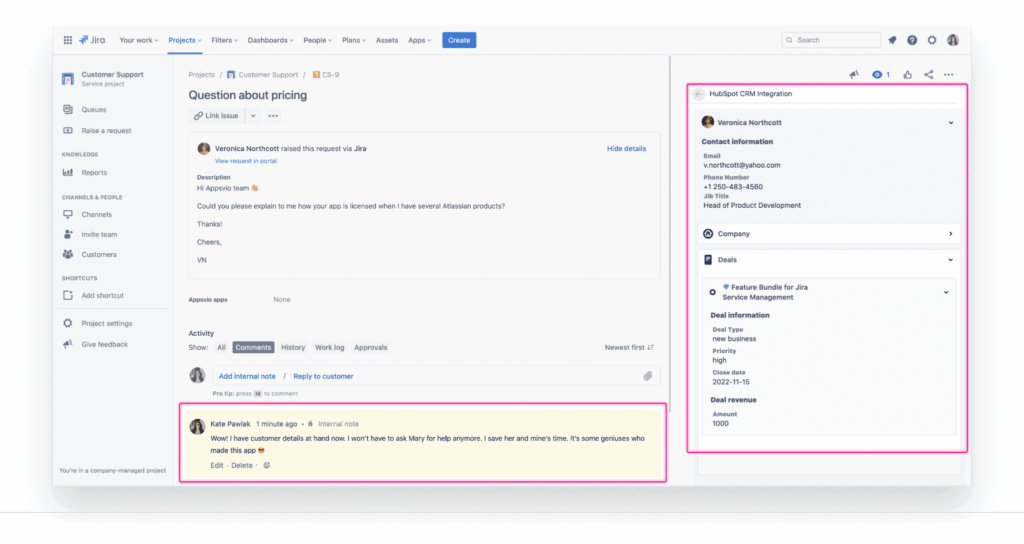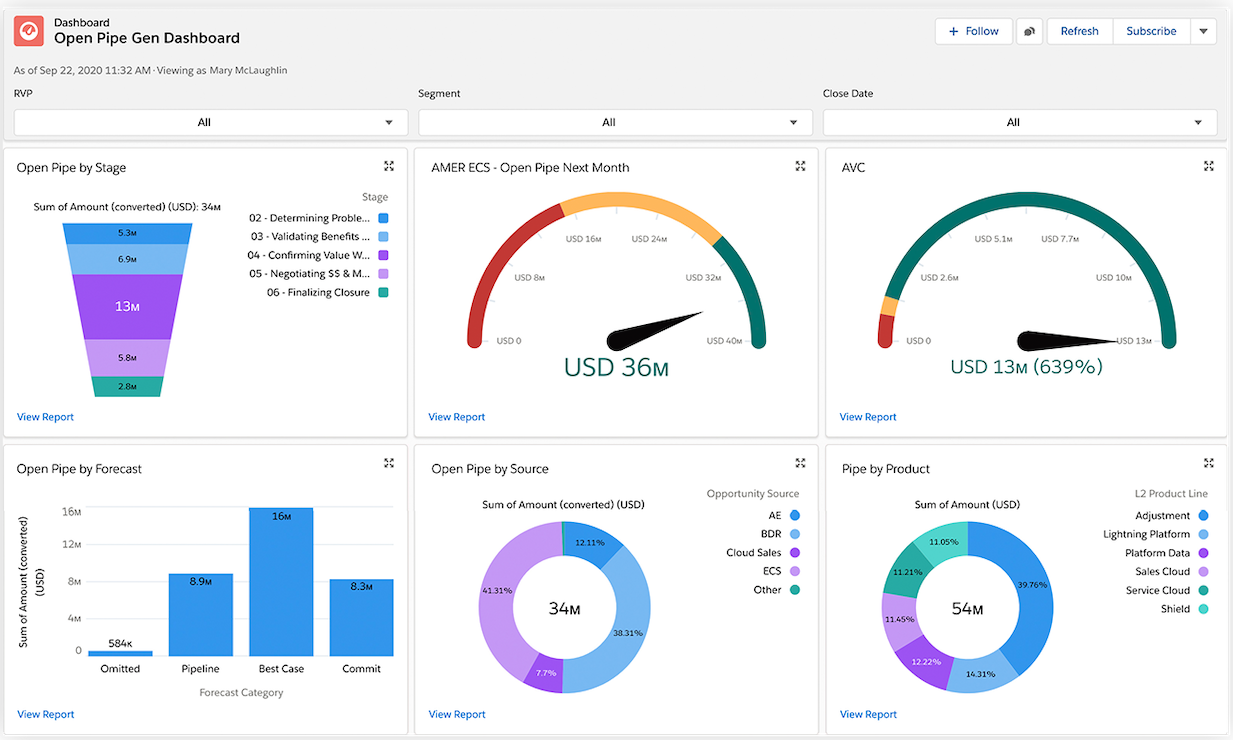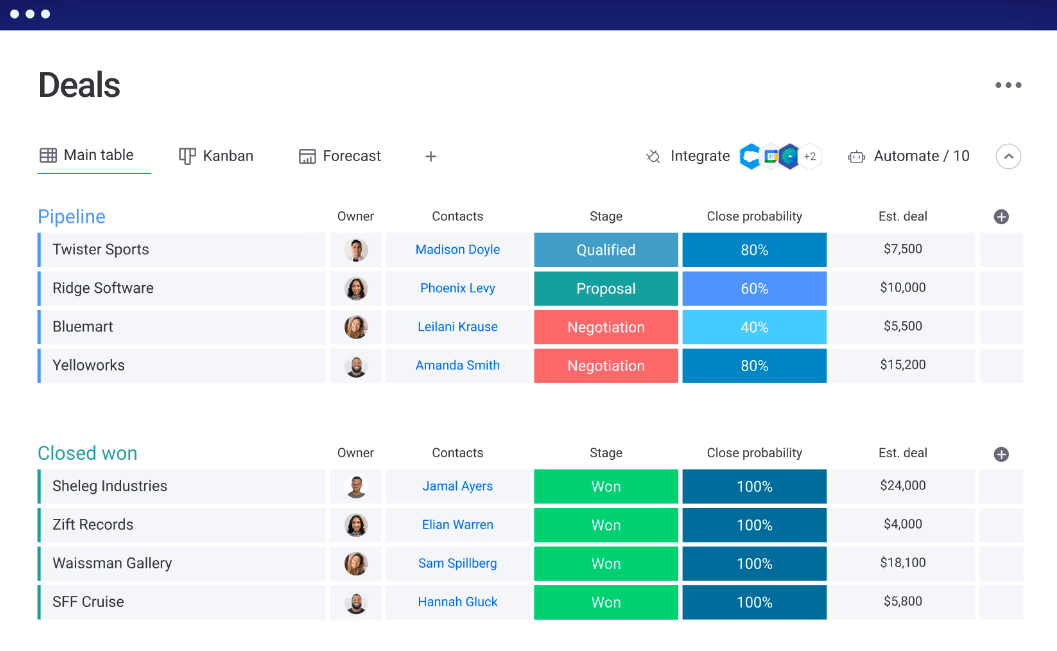
Unlocking Efficiency: The Power of CRM and Jira Integration
In today’s fast-paced business environment, organizations are constantly seeking ways to streamline operations, improve collaboration, and boost overall productivity. One of the most effective strategies for achieving these goals is to integrate Customer Relationship Management (CRM) systems with project management tools like Jira. This powerful combination allows businesses to connect customer data with project workflows, fostering a more holistic and customer-centric approach.
This comprehensive guide delves into the intricacies of CRM integration with Jira, exploring the benefits, implementation strategies, and best practices to help you unlock the full potential of this dynamic duo. Whether you’re a seasoned project manager, a sales professional, or a business owner, this article will provide you with the knowledge and insights you need to leverage the power of integrated CRM and Jira systems.
Understanding the Core Components: CRM and Jira
CRM: The Heart of Customer Relationships
Customer Relationship Management (CRM) is a technology that helps businesses manage and analyze customer interactions and data throughout the customer lifecycle. The primary goal of a CRM system is to improve business relationships with customers, assist in customer retention, and drive sales growth. Key functions of a CRM system include:
- Contact Management: Storing and organizing customer information, including contact details, communication history, and purchase records.
- Sales Automation: Automating sales processes, such as lead generation, opportunity management, and quote creation.
- Marketing Automation: Streamlining marketing campaigns, tracking customer behavior, and personalizing communications.
- Customer Service: Managing customer inquiries, resolving issues, and providing support.
- Analytics and Reporting: Providing insights into customer behavior, sales performance, and marketing effectiveness.
Popular CRM systems include Salesforce, HubSpot, Zoho CRM, and Microsoft Dynamics 365.
Jira: The Engine of Project Management
Jira is a project management and issue tracking software developed by Atlassian. It’s widely used by software development teams, IT departments, and other organizations to manage projects, track bugs, and collaborate on tasks. Key features of Jira include:
- Issue Tracking: Creating, assigning, and tracking issues or tasks.
- Workflow Management: Defining and managing project workflows, including status transitions and approvals.
- Collaboration Tools: Facilitating communication and collaboration among team members.
- Reporting and Analytics: Providing insights into project progress, team performance, and issue resolution.
- Customization: Allowing users to customize workflows, fields, and dashboards to meet their specific needs.
Jira’s flexibility and robust features make it an ideal platform for managing complex projects and workflows.
The Synergy: Benefits of CRM and Jira Integration
Integrating CRM and Jira creates a powerful synergy that benefits various departments and stakeholders within an organization. Here are some of the key advantages:
Enhanced Customer Visibility
By integrating CRM data with Jira, teams gain a 360-degree view of the customer. This means that project teams have access to critical customer information, such as contact details, purchase history, and support interactions, directly within Jira. This comprehensive view enables teams to:
- Understand Customer Needs: Gain a deeper understanding of customer requirements and preferences.
- Personalize Interactions: Tailor project deliverables and communications to meet specific customer needs.
- Improve Customer Satisfaction: Resolve issues more efficiently and provide a better overall customer experience.
Improved Collaboration
Integration fosters better collaboration between sales, marketing, customer service, and project teams. When everyone has access to the same customer data, communication becomes more seamless, and teams can work together more effectively. This leads to:
- Reduced Silos: Breaking down information silos and promoting cross-functional collaboration.
- Faster Issue Resolution: Enabling project teams to quickly access customer information and resolve issues.
- Improved Communication: Streamlining communication and ensuring that everyone is on the same page.
Increased Efficiency
Automation is a key benefit of CRM and Jira integration. By automating tasks and processes, businesses can save time and reduce manual effort. This leads to:
- Automated Data Synchronization: Eliminating the need for manual data entry and ensuring that information is always up-to-date.
- Workflow Automation: Automating tasks such as creating Jira issues from CRM records or updating CRM records based on Jira activity.
- Reduced Errors: Minimizing the risk of human error and ensuring data accuracy.
Data-Driven Decision Making
Integration provides businesses with valuable insights into customer behavior, project performance, and overall business operations. By analyzing data from both CRM and Jira, businesses can make more informed decisions. This leads to:
- Improved Forecasting: Gaining a better understanding of customer needs and predicting future demand.
- Optimized Resource Allocation: Allocating resources more effectively based on project priorities and customer needs.
- Enhanced Performance Tracking: Monitoring key performance indicators (KPIs) and identifying areas for improvement.
Implementing CRM and Jira Integration: A Step-by-Step Guide
Implementing CRM and Jira integration can seem daunting, but with a well-defined plan and the right tools, it can be a smooth and successful process. Here’s a step-by-step guide to help you get started:
1. Define Your Goals and Objectives
Before you begin, it’s crucial to define your goals and objectives for the integration. What do you hope to achieve by integrating CRM and Jira? Do you want to improve customer satisfaction, streamline workflows, or gain better visibility into customer data? Having clear goals will help you choose the right integration method and measure the success of your efforts.
2. Choose the Right Integration Method
There are several ways to integrate CRM and Jira, each with its own pros and cons:
- Native Integrations: Some CRM and Jira systems offer native integrations, which are pre-built connectors that make it easy to synchronize data between the two platforms. These integrations are often the easiest to set up and use, but they may not offer all the features you need.
- Third-Party Integrations: Numerous third-party integration platforms offer more advanced features and customization options. These platforms typically provide pre-built connectors for various CRM and Jira systems and allow you to create custom workflows and data mappings.
- Custom Integrations: If you have specific requirements that aren’t met by native or third-party integrations, you can build a custom integration using APIs (Application Programming Interfaces) and webhooks. This option offers the most flexibility but requires more technical expertise.
Consider your budget, technical skills, and integration requirements when choosing the right method.
3. Select Your Integration Tools
Based on the integration method you choose, you’ll need to select the appropriate tools. If you’re using a native integration, you’ll simply need to enable the integration within your CRM and Jira systems. If you’re using a third-party integration platform, you’ll need to choose a platform that supports your CRM and Jira systems and offers the features you need. Popular integration platforms include:
- Zapier: A popular platform that connects thousands of apps, including CRM and Jira.
- IFTTT (If This Then That): A similar platform to Zapier, offering a wide range of integrations.
- Workato: An enterprise-grade integration platform with advanced features and capabilities.
If you’re building a custom integration, you’ll need to use the APIs provided by your CRM and Jira systems and a programming language of your choice.
4. Map Your Data
Once you’ve chosen your integration method and tools, you’ll need to map your data. This involves defining how data from your CRM system will be synchronized with Jira and vice versa. For example, you might map customer contact information from your CRM to Jira issue fields or map sales opportunities from your CRM to Jira project tasks. Careful data mapping is crucial for ensuring that data is accurate and consistent across both systems.
5. Configure Your Workflows
After mapping your data, you’ll need to configure your workflows. This involves defining how data will be synchronized between the two systems and how tasks will be automated. For example, you might create a workflow that automatically creates a Jira issue when a new support ticket is created in your CRM or updates a CRM record when a Jira issue is resolved. The specific workflows you configure will depend on your business needs and the capabilities of your integration tools.
6. Test and Refine
Before you launch your integration, it’s essential to test it thoroughly. Test all your workflows and data mappings to ensure that they’re working correctly. Make sure that data is synchronizing as expected and that automated tasks are being executed properly. If you find any issues, make adjustments to your configuration and retest until everything is working smoothly. Once the initial setup is complete, continually monitor the integration and refine it over time to optimize its performance and adapt to changing business needs.
7. Train Your Team
Once your integration is up and running, you’ll need to train your team on how to use it. Provide training on how to access and use the integrated data, how to create and manage issues, and how to use the automated workflows. The more your team understands the integration, the more effectively they’ll be able to use it.
Best Practices for Successful CRM and Jira Integration
To maximize the benefits of CRM and Jira integration, follow these best practices:
1. Start Small and Iterate
Don’t try to integrate everything at once. Start with a small set of features and workflows and gradually expand the integration as you gain experience and identify new opportunities. This approach allows you to test and refine your integration in a controlled environment and minimize the risk of disruption.
2. Document Your Processes
Document your integration setup, including your data mappings, workflows, and any custom configurations. This documentation will be invaluable for troubleshooting issues, training new team members, and making future updates to your integration.
3. Monitor Your Integration
Regularly monitor your integration to ensure that it’s working correctly. Check for errors, data synchronization issues, and performance problems. Set up alerts to notify you of any issues so that you can address them promptly.
4. Keep Your Systems Updated
Keep your CRM and Jira systems up to date with the latest versions. Software updates often include bug fixes, performance improvements, and new features that can enhance your integration. Staying current also helps ensure compatibility with your integration tools.
5. Prioritize Data Security
Protect your customer data by implementing security best practices. Use strong passwords, encrypt sensitive data, and regularly review your security settings. Ensure that your integration tools comply with relevant data privacy regulations.
6. Provide Ongoing Training
Provide ongoing training to your team to ensure that they’re up-to-date on the latest features and best practices. This will help them use the integration more effectively and maximize its benefits.
7. Seek Expert Advice
If you’re unsure how to implement CRM and Jira integration, consider seeking expert advice. Consultants and integration specialists can help you choose the right integration method, configure your systems, and provide training and support.
Real-World Examples: CRM and Jira Integration in Action
To illustrate the practical application of CRM and Jira integration, let’s look at a few real-world examples:
Scenario 1: Software Development Company
A software development company uses Salesforce as its CRM and Jira for project management. When a new support ticket is created in Salesforce, the integration automatically creates a Jira issue, assigning it to the appropriate development team. The Jira issue includes all relevant customer information from Salesforce, such as the customer’s contact details, purchase history, and the nature of the problem. As the development team works on the issue, they update the Jira issue with their progress, which is then automatically synchronized with the Salesforce record. This allows the sales team to stay informed about the status of the customer’s issue and provide timely updates.
Scenario 2: Marketing Agency
A marketing agency uses HubSpot as its CRM and Jira for project management. When a new lead is qualified in HubSpot, the integration automatically creates a Jira project for the lead, assigning it to the appropriate project manager. The Jira project includes all relevant information from HubSpot, such as the lead’s contact details, marketing campaign data, and the services they’re interested in. The project manager then uses Jira to manage the project, track tasks, and collaborate with the team. The integration synchronizes project updates with HubSpot, allowing the sales team to track the progress of the project and provide updates to the lead.
Scenario 3: IT Support Team
An IT support team uses Zoho CRM as its CRM and Jira for issue tracking. When a customer submits a support request through Zoho CRM, the integration automatically creates a Jira issue, assigning it to the appropriate support technician. The Jira issue includes all relevant customer information from Zoho CRM, such as the customer’s contact details, the nature of the issue, and any previous support interactions. As the support technician resolves the issue, they update the Jira issue with their findings and resolution steps, which are then automatically synchronized with the Zoho CRM record. This allows the support team to provide efficient support and track the resolution of customer issues.
Choosing the Right Integration Partner
While the examples above highlight the benefits of CRM and Jira integration, the success of your integration largely depends on the tools and partners you choose. Here’s what to consider when selecting your integration partner:
- Integration Platform Support: Ensure the platform supports both your CRM and Jira systems.
- Pre-built Connectors: Look for pre-built connectors to simplify the setup process.
- Customization Options: Verify the platform offers customization options to meet your specific needs.
- Data Mapping Capabilities: Confirm the platform allows for flexible data mapping between systems.
- Workflow Automation: Check if the platform supports the workflows you need to automate.
- Security and Compliance: Prioritize a platform that adheres to security best practices.
- Pricing and Support: Consider the pricing model and the availability of customer support.
Choosing the right integration platform is crucial for a seamless and effective integration process. Researching and comparing different platforms is a must before making your final decision.
The Future of CRM and Jira Integration
The integration of CRM and Jira is a constantly evolving field. As technologies advance, we can expect to see even more sophisticated integrations and features. Some trends to watch for include:
- AI-Powered Automation: Artificial intelligence (AI) will play an increasingly important role in CRM and Jira integration. AI can automate tasks, provide insights, and personalize customer interactions.
- Enhanced Analytics: Advanced analytics will provide businesses with even more insights into customer behavior, project performance, and overall business operations.
- Mobile Integration: Mobile apps will enable teams to access and manage data from CRM and Jira systems on the go.
- Integration with Other Tools: Integration will expand to include other business tools, such as marketing automation platforms, communication tools, and collaboration platforms.
These advancements will further enhance the power and efficiency of CRM and Jira integration, enabling businesses to achieve even greater success.
Conclusion: Embracing the Integrated Future
CRM and Jira integration is a powerful strategy for businesses looking to improve customer relationships, streamline workflows, and boost productivity. By connecting customer data with project workflows, businesses can gain a 360-degree view of the customer, improve collaboration, and make more informed decisions. Implementing CRM and Jira integration requires careful planning, the right tools, and a commitment to best practices. However, the benefits – increased efficiency, improved customer satisfaction, and better business outcomes – are well worth the effort. Embrace the integrated future and unlock the full potential of your CRM and Jira systems.


